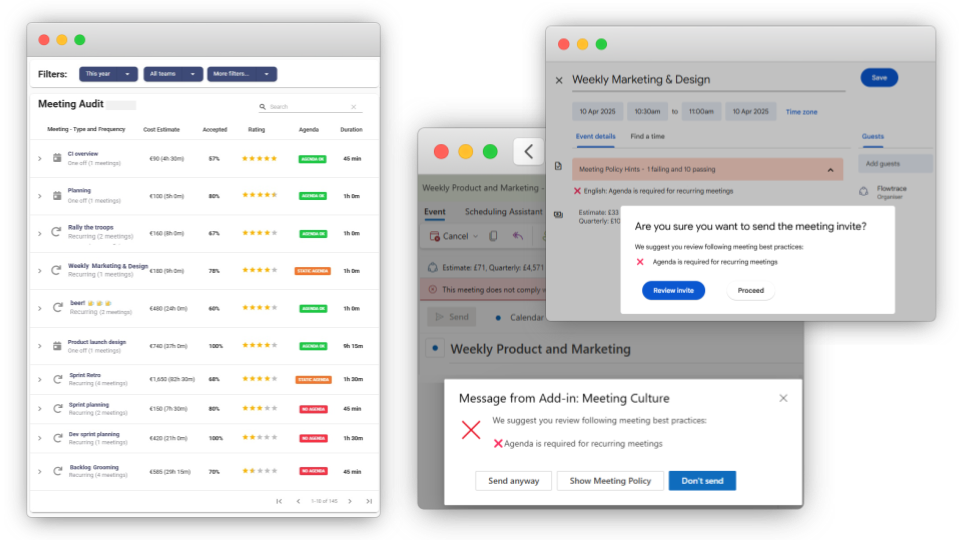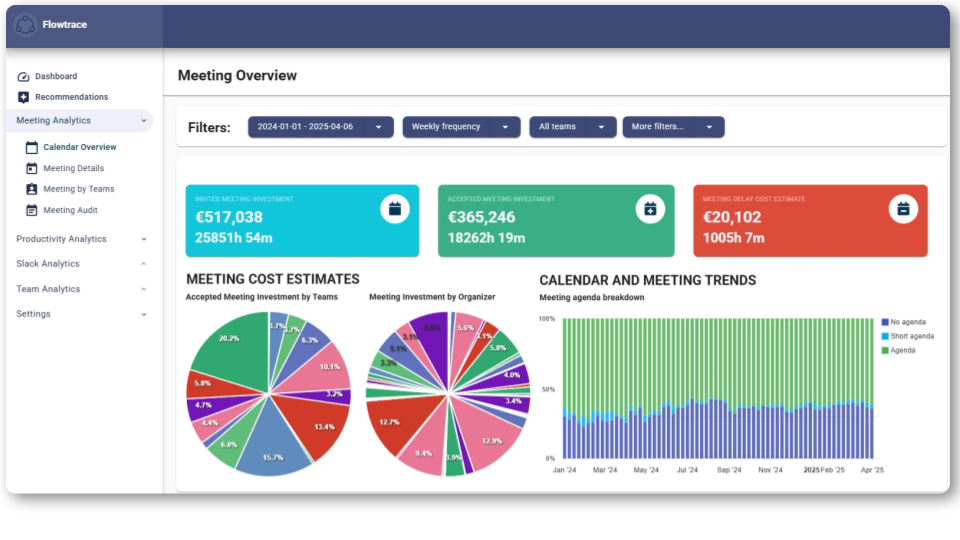In 2023, Shopify made global headlines when it deleted 12,000 recurring meetings overnight. Employees opened their calendars to find blank spaces where endless syncs used to live. It wasn’t chaos, it was clarity.
Executives everywhere took note. Many have since wondered: Could we cancel most meetings too?
It’s a question worth asking, not out of trend-chasing, but necessity. For many organisations, meetings have quietly become the single largest tax on focus, energy, and decision velocity. The opportunity isn’t to eliminate communication; it’s to redesign how collaboration happens.

The Meeting Problem We Pretend Not to See
Every leader knows there are too many meetings. Few can quantify how bad it’s become.
The modern workplace runs on recurring invites, stand-ups, check-ins, retros, updates. They feel harmless in isolation, but their cumulative impact is staggering. Research by Atlassian found that employees attend an average of 62 meetings per month, and half of those meetings are considered a waste of time, costing teams countless hours of lost productivity.
Unnecessary meetings cost large organizations tens of millions of dollars a year in lost productivity and salary waste. Yet because these costs are invisible, hidden in calendars and time slots, most teams treat them as unavoidable.
The truth is simpler: meetings are a habit. They accumulate faster than we retire them, and without intervention, they slowly smother focus.
Why Leaders Are Finally Ready to Cancel Meetings
In the past, canceling meetings looked risky, almost anti-collaborative. Leaders feared silence might signal disengagement.
But the world of work has shifted. Remote and hybrid models have stretched calendars across time zones. Employees balance more digital tools than ever, and burnout from context-switching is real.
Executives now see meetings less as the glue that holds teams together and more as the friction that slows them down. The conversation has moved from “How do we meet more efficiently?” to “Why are we meeting at all?”
Forward-thinking organizations are discovering that deleting meetings isn’t chaos, it’s strategy. It forces clarity: which conversations genuinely drive progress, and which persist only from habit or fear of missing out.
Why You Can’t Cancel Everything
Shopify’s bold experiment inspired thousands of LinkedIn posts, but few noticed the nuance: it didn’t ban meetings entirely. It reset the baseline.
Canceling every meeting creates its own problems. Without structured coordination, decisions drift, misalignment grows, and new “shadow meetings” appear in chat threads and DMs. Teams don’t collaborate less; they just do it informally and inefficiently.
That’s why the goal isn’t no meetings, but better meetings, and far fewer of them.
The target many high-performing organizations are now adopting is a 70–80% reduction in recurring meetings. The remaining 20% are designed intentionally: decision-driven, time-boxed, and clearly owned.
Step 1: Audit the Reality
You can’t cancel what you don’t understand. Start with a 30-day snapshot of your meeting load, by person, team, and purpose.
Most leaders are shocked by the results. In many cases, half of all meetings are recurring with no clear agenda or owner. Entire teams spend upwards of ten hours per week in sessions that produce no measurable output.
This audit is where change begins. It’s not about blame; it’s about transparency. Once you visualize the scale of the issue, the business case for change becomes impossible to ignore.
Step 2: Redesign, Don’t Just Remove

After the audit, classify every meeting by intent, decision-making, information-sharing, planning, or culture. Each category demands a different approach:
- Decision-making meetings stay but shrink. Keep them short, outcome-focused, and limited to decision-makers.
- Information-sharing meetings move async. A weekly call can often become a shared update or short Loom video.
- Recurring status meetings consolidate or retire. If nothing has changed for several cycles, the meeting’s job is done.
- Team health or social rituals remain but become intentional, not automatic.
What emerges is a simpler, leaner operating rhythm, one that favors visibility over repetition.
Step 3: Communicate the Why
Cutting 80% of meetings can feel radical if teams don’t understand the purpose. Without context, employees interpret silence as disconnection.
Explain the reasoning clearly: the aim isn’t fewer conversations but more meaningful ones. Share the audit data, quantify the hours reclaimed, and describe what the freed-up time enables: deeper work, faster execution, better well-being.
Cultural alignment comes from shared understanding, not shared calendars.
Step 4: Rebuild Alignment Without the Meetings
A 2022 study found that employees who cut their meeting time by 40 percent experienced 71% higher productivity and 55% better engagement. However, canceling meetings works only when you replace them with more efficient alignment systems. That might include:
- Async updates, daily summaries posted to shared tools instead of synchronous calls.
- Decision documentation, written records that make alignment traceable.
- Regular retrospectives, short monthly sessions to reflect on what’s working.
- Protected focus blocks, organization-wide no-meeting hours.
Step 5: Measure the Change

After the initial reduction, measure outcomes. Focus on:
- Meeting hours per person per week.
- Focus-time ratio (how much of each week is free for deep work).
- Decision velocity , time from idea to signed-off action.
- Employee sentiment around productivity and clarity.
When these metrics improve, momentum builds naturally. People start challenging unnecessary invites on their own. The cultural shift sustains itself because everyone feels the impact of reclaimed time.
Step 6: Prevent the Creep
Meeting overload always creeps back. New projects bring new syncs. Teams grow, and someone adds a “quick weekly catch-up.”
To maintain progress, leaders should treat meeting hygiene like technical debt, a constant area of maintenance. Review meeting load quarterly, retire outdated series, and reinforce norms around agenda, purpose, and attendance.
The healthiest meeting cultures embed meeting reduction as an operating discipline, not a one-off clean-up.
How Flowtrace Helps Organizations Do It Intelligently
Meeting reduction without insight can be risky. Flowtrace provides the analytical foundation for confident action.
.png?width=960&height=540&name=Marketing%20Images%20(11).png)
By connecting to your organization’s calendars, it visualizes exactly where time is going, which teams are overbooked, which meetings repeat without purpose, and how focus time fluctuates over weeks.
Rather than guessing which 80% to cancel, leaders use this visibility to act surgically. Once changes are made, Flowtrace tracks the results: total hours saved, collaboration cost reduced, and focus-time restored.
The platform turns what’s often a subjective conversation into a measurable transformation, ensuring that meeting reduction creates alignment, not chaos.
Cancel Meetings, Keep Alignment
Canceling meetings isn’t a rejection of collaboration; it’s a recalibration of it.
When you remove the unnecessary and protect the meaningful, you free teams to think, build, and deliver again. The result isn’t less communication, it’s clearer alignment, sharper focus, and a healthier organization.
Start with an audit. Cancel with purpose. Replace chaos with clarity.
Because the most productive teams aren’t the ones that meet most often, they’re the ones that meet only when it truly matters.

Frequently Asked Questions - How to Cancel Meetings